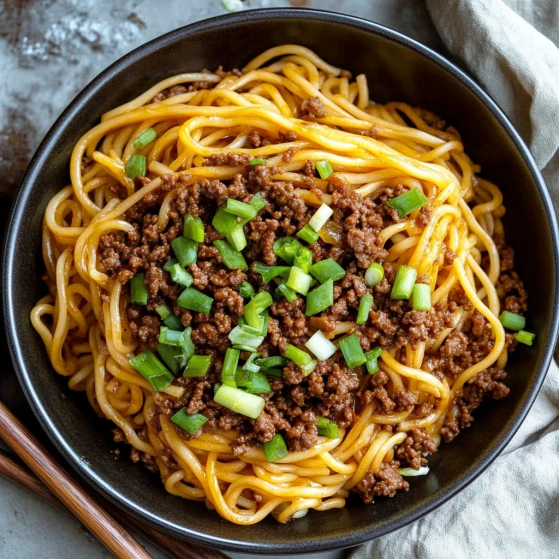 Pin it
Pin it
This savory-sweet Mongolian ground beef noodle dish transforms ordinary weeknight dinners into something extraordinary. The combination of tender ground beef coated in a rich, glossy sauce with perfectly cooked linguine creates a restaurant-quality meal without the restaurant price tag. The balance of sweet brown sugar with salty soy sauce and the complex flavor of hoisin makes this dish irresistibly good, while the quick preparation time makes it practical for busy evenings.
I first tried this recipe when I needed something quick after a particularly exhausting workday. My family devoured it so completely that I had to make it again two days later. It's now in our regular rotation, especially on those evenings when takeout seems tempting but the budget disagrees.
Ingredients
- Ground beef (1 lb): 80/20 lean-to-fat ratio works best here; the fat adds flavor but you can use leaner beef if preferred
- Garlic (5 cloves, minced): Fresh is essential for authentic flavor; look for firm bulbs with no sprouting
- Brown sugar (1/3 cup): Provides the signature sweetness; dark brown sugar adds more molasses flavor if you have it
- Beef broth (1/4 cup): Adds depth; use low-sodium if you're watching salt intake
- Soy sauce (1/3 cup): The umami foundation of the sauce; choose regular or low-sodium based on preference
- Hoisin sauce (3 tablespoons): This fermented bean paste gives authentic Chinese flavor; find it in the international aisle
- Ground ginger (1/2 teaspoon): Adds warmth and spice; fresh grated ginger (1 tablespoon) can be substituted for more punch
- Ground black pepper (1/2 teaspoon): Provides subtle heat without overwhelming
- Red pepper flake (pinch, optional): Adjust according to your heat preference
- Linguine (10 oz): The flat surface captures sauce well; substitute rice noodles for a gluten-free option
- Cornstarch (1 tablespoon): Creates that glossy, thick sauce; ensure it's fully dissolved to avoid lumps
- Water (2 tablespoons): For creating the cornstarch slurry
- Green onions (4, sliced): Adds fresh crunch and color; separate white parts for cooking and green for garnish
Cooking Instructions
- Step 1:
- Bring a large pot of water to a rolling boil. Add a generous pinch of salt (about 1 tablespoon) to flavor the pasta as it cooks. Add the linguine and cook according to package directions until al dente, usually 9-11 minutes. Stir occasionally to prevent sticking. Reserve 1/4 cup of pasta water before draining in case you need to loosen the sauce later. After draining, toss the noodles with a tiny drizzle of oil to prevent sticking if not using immediately.
- Step 2:
- While the pasta cooks, place a large skillet over medium-high heat. Once hot, add the ground beef, breaking it into small pieces with a wooden spoon. Cook until no longer pink, about 5-7 minutes. If there's excessive fat, tilt the pan and spoon it out, leaving about 1 tablespoon for flavor. The beef should have some browned edges for maximum flavor, so don't rush this step.
- Step 3:
- Reduce heat to medium and add the minced garlic directly to the beef. Stir continuously for 60 seconds until fragrant but not browned. Garlic burns easily, so keep it moving in the pan. If using the white parts of green onions for extra flavor, add them now as well.
- Step 4:
- Pour in the soy sauce and beef broth, using the liquid to scrape up any browned bits from the bottom of the pan—these contain concentrated flavor. Add the brown sugar, hoisin sauce, ground ginger, black pepper, and red pepper flake if using. Stir thoroughly to combine all ingredients and allow the mixture to come to a simmer.
- Step 5:
- In a small bowl, whisk together cornstarch and cold water until completely smooth with no lumps. This is your slurry. Pour it into the simmering sauce while stirring constantly. Continue stirring as the sauce comes back to a gentle boil and thickens, about 2-3 minutes. The sauce should coat the back of a spoon but still be pourable.
- Step 6:
- Add the drained linguine directly to the sauce in the skillet. Use tongs to gently toss the noodles until they're completely coated with sauce. Allow everything to simmer together for 2-3 minutes, which helps the noodles absorb the flavor. If the sauce becomes too thick, add a splash of the reserved pasta water. Finally, toss in most of the sliced green onions, reserving some for garnish.
 Pin it
Pin it
I particularly love the hoisin sauce in this recipe. My grandmother introduced me to it years ago in her kitchen, claiming it was "the secret to good Asian cooking." Now, whenever I open a jar, that distinctive aroma takes me back to Sunday dinners at her table. My children, who typically avoid "mixed foods," happily devour this dish and always ask for seconds.
Time-Saving Variations
Mongolian beef noodles can be adapted for even busier evenings with a few simple tweaks. Pre-minced garlic (though not as flavorful as fresh) cuts down on prep time significantly. You can also prepare the sauce mixture ahead of time and store it in the refrigerator for up to three days. Additionally, leftover rotisserie chicken or pre-cooked shrimp can substitute for ground beef, reducing cooking time by nearly half. These modifications preserve the essence of the dish while accommodating hectic schedules without sacrificing the comfort of a home-cooked meal.
Storage and Reheating Tips
Properly stored in an airtight container, this Mongolian beef noodle dish maintains its quality in the refrigerator for up to four days. The flavors often intensify overnight as the noodles continue absorbing the sauce, making it even more delicious the next day. When reheating, add a splash of water or beef broth to loosen the sauce before microwaving in 30-second intervals, stirring between each. For best texture, cover the container with a damp paper towel during reheating to introduce some steam and prevent the noodles from drying out.
 Pin it
Pin it
Nutritional Adaptations
This versatile recipe welcomes modifications to suit various dietary needs without compromising on taste. For a lower-carb version, substitute the linguine with spiralized zucchini or shirataki noodles, reducing carbohydrates by over 30 grams per serving. Those watching sodium intake can use low-sodium soy sauce and beef broth, cutting salt content nearly in half. The dish also transforms easily into a complete meal-prep option by adding steamed broccoli or snap peas during the final heating stage, increasing the fiber and vitamin content while adding vibrant color to your plate. These thoughtful adaptations make the recipe accessible to those with specific nutritional considerations.
Frequently Asked Questions
- → Can I use a different type of pasta?
Yes, you can substitute linguine with spaghetti, fettuccine, or your preferred pasta. Thinner noodles like rice noodles could also work well for a lighter option.
- → How can I make the dish spicier?
For more spice, increase the red pepper flakes or add a drizzle of sriracha or chili oil to the sauce. You can also garnish with sliced fresh chilies.
- → Can I substitute ground beef with another protein?
Absolutely! Try substituting ground beef with ground turkey, chicken, pork, or even a plant-based ground meat alternative for a vegetarian option.
- → What vegetables can I add to this dish?
You can enhance the dish with vegetables like bell peppers, snap peas, shredded carrots, or broccoli. Sauté them with the garlic for extra flavor and texture.
- → How do I store leftovers?
Store leftovers in an airtight container in the refrigerator for up to 3 days. Reheat gently in a skillet or microwave, adding a splash of water or broth to loosen the sauce if needed.
